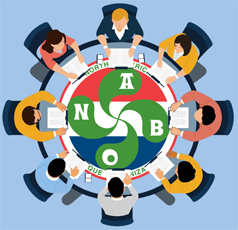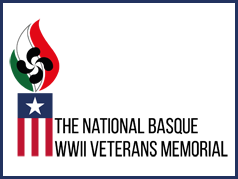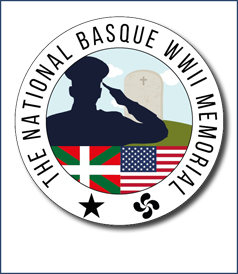Astero
ARTZAIN MUNDUA: Shepherd World Forum
The organization Artzain Mundua is developing the I Global Encounter of Basque Shepherds between the days 28 of September and 1 of October. It actually consists of two separate but related encounters, with one taking place in Aldude (in the Iparralde or north-side of the Basque Country) and another in Gernika (in the Hegoalde or south-side).
Among the invited shepherds to be honored are American Basque shepherds. To them the organizers of Artzain Mundua extend an invitation. It will be a magnificent opportunity at the Encounter for all, for the ones that returned and for the ones that they remained. This special meeting will serve to recall, to share, and as not for recognize and to thank to all these shepherds the enormous effort that supposed leaving the Basque Country in a period of maximum economic, political, and social uncertainty.
BEGINNINGS. Artzain Mundua is an association whose work focuses on the development and promotion of the shepherd and the traditional trade of shepherding. It began its work in 2002 with the organisation of the First World Congress of Shepherds in Arantzazu. That experience served the purpose of putting in motion in the world of shepherding an integral work dynamic on all aspects of this livestock caring activity. Here, in Arantzazu, where spirituality, culture, and nature and in harmony, we have been working ten years for the promotion of the Basque shepherd from an innovative perspective. In addition to livestock caring activity in itself, others are carried out with training and on culture. This work stems from the conviction that this age-old trade can aspire to, and achieve, like any other economic activity, a future development with a guarantee of continuity.
During these five years, Artzain Mundua has converted itself, within the Basque Country, in the cultural beacon of Basque shepherding. Three world congresses, the launch of the Shepherding Documentation Centre and the Shepherd Forum, the cinematic experience with Nekazaldia, the creation of a multidisciplinary and specialised database on the world of the shepherd, the consolidation of the project as a nationally and internationally renowned institution obtained trough the exchange of experiences, the permanent presence and ceaseless work of the various media involved in the organisation’s communication strategy and, above all, the success obtained in the achievement of the Professional and Social Recognition of this livestock caring profession within the Basque Country are all essential factors to keep in mind when learning about this pioneering project..
Among other activities carried out up to this point, we can single out those relating to the Iragana Gaurkotuz project. This project is a part of the strategic area of the Documentation Centre. Through it, beyond the research and compilation of existing documentation on shepherding, very scattered today, it also aims to create the dynamic for documental production in this area. Within this set of tasks, the so-called Traditional Shepherding and Basque Shepherding on the American Continent are particularly relevant. On the one hand because shepherding knowledge and stories of that time for part of the Collective Memory of Basque shepherding over the last 100 years, and on the other because the age of the protagonists constitutes a natural constraint that requires the quick implementation of the project.
With this in mind, Artzain Mundua fostered the first encounter of shepherds of the diaspora in one of the acts of the Third World Congress celebrated in Arantzazu in September 2005. Through this initiative Artzain Mundua was able to see the scarcity of information that exists about these shepherds, especially, among others, the absence of a specific database, a key part of managing the event. In spite of these difficulties, at last, a total of 50 shepherds attended, principally from Navarra and Iparralde.
From that time Legazpia, Lesaka and Sunbilla have launched their own initiatives. These three municipalities have had the necessary humility to recognise this group of professionals. In each one of the towns, the emigrating shepherd has been a leading protagonist. With the presence and first-hand accounts of all of the professionals, the events have become real acts of appreciation and gratitude. The effort realised, the difficulties overcome and, to a great degree, their special contribution as ambassadors to the spreading of Basque culture outside of the Basque Country are the elements brought by these shepherds to this emigration adventure.
And in this year 2007, the towns of Aldude y Gernika, will take part in this type of events by reuniting for the first time all the emigrating shepherds, as much from Iparralde and Navarra as from the three territories of the Basque Autonomous Community. In addition to reviving the old memories of these people who one day left the Basque Country to “take to the Americas”, these municipalities are preparing themselves to show their recognition and gratitude to all of them.
CULTURAL CHARACTER OF THE PROGRAMME When the time comes to set a date for the start of this initiative we must go back to 2003, when the commission of the Gipuzkoa/Aizarna/Eguino event proposed to the newly formed Artzain Mundua an article on the emigration of Basque shepherds to America. It did not turn out to be an easy task given that in addition to a great lack of knowledge on the topic there is the scarcity of documents and references on the matter. Still, this challenge set the stage for a work dynamic which has led us to a stage at which, in addition to wanting to express gratefulness to the protagonists, the further objective has been set to begin a documentary labour to recuperate this collective memory.
This first experience began to take shape at the time that Artzain Mundua fostered the first encounter of emigrant shepherds during its Third World Congress. As previously mentioned, the event could not reunite more than 50 shepherds. These, however, have been the starting point for those who have appeared afterward in the various events carried out as well in Legazpia, Sunbilla and Lesaka.
These experiences, initially of clearly local interest, crossed the media barrier and have awakened a great interest in our society. Simultaneously, they have served to create a conscience on the cultural value that they represent. In fact, if the initiative, as is the intention, is open to all those municipalities of the Basque Country that, to whatever degree, experienced that emigration of their young shepherds, the cultural relevance will be made evident by the fact that we are dealing with a part of history written by Basque shepherds during more than 150 years of emigration.
The new project represents a step forward in awareness promotion of the lifestyle of Basque shepherds. Through it, the intention is to undertake the recovery of the Collective Memory still in existence in the protagonist shepherds and recuperate one of the most recent stories of our shepherding and of therefore also of the Basque Culture.
TERRITORIAL REPERCUSSION AND OTHER DATA OF GENERAL INTEREST. Both encounters will be organised in the municipalities of Aldude and Guernica. In both cases shepherds will be invited, principally through media announcements, shepherds from all the territories of Iparralde, the north of Navarra, and of the Basque Autonomous Community, with special participation in the latter by the shepherds of the Vizcaya Territory. Among others, the reasons for the selection of these two municipalities are the following:
ALDUDE. This is a small village of Behe-Nafarroa that also lends its name to the valley in which the villages of Urepel, Banka and Baigorri are also found. In times past it was a free passing zone for shepherds who set up their cabins where it suited them. In this valley the famous bertsolari (Basque improvising poet) Xalbador was born who, in addition to being a poet, was himself an emigrant shepherd to America. He represents the epitome of the perfect combination between improvised poetry and shepherding. From Neolithic times oral communication and shepherding have jointly travelled a large journey through time up to the present days in, in which new technologies have represented a revolution for this traditional profession. With the representative figure of Xalbador in this shepherding valley, the aim is to find an incomparable setting to make possible the encounter of all the shepherds of Iparralde who experienced emigration.
GERNIKA (GUERNICA). This is the most renowned municipality of Busturialdea in Vizcaya. Although industry and the service sector are the economic motor of this town, Guernica maintains alive, through its weekly fairs, the agricultural and livestock keeping activities that once gave meaning to the lifestyle of its inhabitants. These fairs have in addition converted Guernica in a meeting point for farmers from the town itself as well as neighbouring ones. Here they also found a reason for the re-encounter of the emigrant shepherds of Forua, Kortezubi, Arratzu, Muxika, Aulesti, Munitibar, Gizaburuaga, Bolibar, etc., who after their return sought to maintain their experience as shepherds on the American continent. The intention is that the shepherds may have the opportunity to meet once again in Guernica as it always was but also on this occasion in the context of a celebration prepared exclusively for them.
TARGET PUBLIC. At this time, the total number of emigrating shepherds in the Basque Country is still not known exactly. However, based on the numbers who attended last October in Lesaka we can estimate that today there are about 2000. With this number in mind the number of persons who have a direct link with these shepherds, mainly familiar, the number of people interested in this event may reach 50,000. Beside this potential interested public, we must not forget the general interest that this type of event produces because its protagonists are a part of our recent history.
There are many Basque communities that confronted emigration to be able to survive such difficult times. The great majority of them were municipalities with an exclusively rural economy and they remain to this day the rural livestock communities of the Basque Country.
Vizcaya: Amoroto, Arteaga, Aulesti, Bakio, Bermeo, Berriatua, Berriz, Bolibar, Busturia, Derio, Dima, Durango, Ea, Elantxobe, Elorrio, Ereño, Errigoiti, Forua, Fruiz, Galdakao, Gamiz-Fika, Garai, Gatika, Gizaburuaga, Ibarrangelu, Igorre, Ispaster, Iurreta, Kortezubi, Larrabetzu, Lekeitio, Lemoa, Lezama, Mallabia, Mañaria, Markina, Maruri, Mendexa, Morga, Mungia, Munitibar, Muxika, Nabarniz, Otxandio, Zaldibar, Zamudio, Zaratamo, Zeanuri, Zeberio, Zornotza, etc.
Iparralde: Ahatsa, Ainiza Mongolose, Aintzile, Aldude, Anauze, Arnatsugi, Arnegi, Arrosa, Azcarate, Baigorri, Banka, Behorlegi, Bidarrai, Bunuze, Donaixti, Donazaharre, Donibane Garazi, Duzunaritze, Eiheralarre, Ezterenzubi, Gamarte, Heleta, Ibarla, Iholdi, Irisarri, Irukegi, Itsasu, Izura, Jatsu, Lakarra, Landibarre, Larraine, Larzabale, Lasa, Lekunberri, Luhosoa, Makea, Mendibe, Ortzaize, Pagola, Sara, Suhuskune, Urepel, etc.
Navarra: Altsasu, Almandoz, Amaiur, Aranaz, Arantza, Beintza-Labaien, Bera, Bertiz, Donamaria, Doneztebe, Elizondo, Elgorriaga, Erasun, Erratzu, Etxalar, Ezkurra, Gaztelu, Hurtos, Iantzi, Iruina, Irurita, Ituren, Labayen, Legasa, Leitza, Lekaroz, Narbarte, Oieregi, Oitz, Saldias, Sunbilla, Zubieta, Zumatzu, Anue Ibarra- Aritzu, Burutain, Egozkue, Etsain, Etulain, Leazkue, Olague- Atetz Ibarra- Amalain, Aroztegi, Beratsain, Beuntza, Beuntza-Larrea, Egillor, Eguarats, Eritze, Hiriberri, Ziganda- Basaburua Ibarra- Aizarotz, Arrarats, Beramendi, Beruete, Erbiti, Gartzarun, Igoa, Ihaben, Itsaso, Jauntsarats, Orokieta, Udabe- Imotz Ibarra- Etxaleku, Eraso, Goldaratz, Latasa, Muskitz, Oskotz, Urritza, Zarrantz- Larraun Ibarra- Albiasu, Aldatz, Alli, Arruitz, Astitz, Azpirotz, Baraibar, Errazkin, Etxarri, Gorriti, Iribas, Lezaeta, Madotz, Mugiro, Oderitz, Uitzi- Lekunberri- Odieta Ibarra- Anotzibar, Erripa, Gaskue, Gelbentzu, Gendulain, Latasa, Ostitz, Ziaurritz- Ultzama Ibarra- Alkotz, Arraitz-Orkin, Auza, Eltso, Eltzaburu, Gerendiain, Gorrontz-Olano, Ilargi, Iraizotz, Larraintzar, Lizaso, Urritzola-Galain, Suarbe, Zenotz. Erro Ibarra, Aintzioa, Ardaitz, Biskarret, Erro, Esnotz, Lintzoain, Loizu, Mezkiritz, Orondritza, Zilbeti. Aezkoa Ibarra, Abaurreagaina, Abaurrepea, Aria, Aribe, Garaioa, Orbaizeta y Orbara. Artze Ibarra, Arce, Arrieta, Burgete, Gorraitz, Imizkotz, Nagore, Uritz, Zaragueta.
Gipuzkoa: Zegama, Urretxu, Arretxabaleta, Oñati, Bergara, Irun, etc.
Araba: Oiardo, Harana, Agurain, Marieta, etc.
LANGUAGE. The events will use Basque as the main communications means. Except for a few interventions on radio, the written press, etc. the main core of activities will be held exclusively in Basque. Furthermore, it is necessary to highlight in this document that the shepherds, as part of the farming community, have been are continue to be an example of loyalty to their land and mother tongue; consequently this will be the natural mode of communication with all of them.
OBJECTIVES. Without doubt, this is the first phase of a long-term project. It is probably that in addition to the objectives mentioned here others may be achieved resulting from the project’s development. With out creating further expectations, the most immediate objectives of these events are the following:
Making possible the re-encounter of these shepherds.
Offer the opportunity to recall particular experiences.
Identify the protagonists for the construction of a database, a fundamental part of the Iragana Gaurkotuz project for the recovery of the collective memory of Basque shepherding.
To recover information from a period that lasted over 150 years and which will be converted into the legacy of these shepherds for future generations.
Repay the debt that our society owes to this group of shepherds through the appreciation and gratitude that they deserve for their efforts and for having contributed in a very important way to the dissemination of Basque shepherding culture as a whole in the vast continent that is America.
STONE MONUMENT. In addition to the objectives listed above, we have wanted to convert the memory of this long history into a symbol that may show in a permanent way the gratitude and appreciation to this group. This will be a monument in stone whose main function will to represent the long story of emigration of the Basque shepherds. The motto of this important encounter will be sculpted upon it: “Ohore Zuri Euskal Artzaina”. The monument will be a tribute to all these shepherds and will serve to commemorate an important part of the history of our shepherding ancestors.
AGENDA. The celebration of both events will be during the last week of September. The two events will follow the line of a single incorporated agenda. The various activities will be distributed between the territory of Vizcaya and that of Baxenabarre.
PROGRAMME
Friday, September 28th (Bilbao)
12:00. Roundtable:
Title: To remain in America or return to the Basque Country: a decision, a destiny.
Guests: Basque-American shepherds and shepherds who returned from America.
Saturday, September 29th. (Baigorri).
20:00. BiL Etxea.
Documentary on the accounts of the Iparralde Basque shepherds who emigrated to America. Producción EKE.
Concert: Xalbador-Ihidoy eta Magali Zubillaga
Speech: inscription of the shepherds on the cottonwoods. Joxe Mallea
Presentation: EKE
Sunday, September 30th. (Aldude)
11:00. Mass for all shepherds.
12:30. Presentation of the stone monument in memory of all the Basque shepherds. Declaration of appreciation to the shepherds by Artzain Mundua
14:00. Meal in the Aldube pitch. Distribution of distinguishing bandanas to the emigrating shepherds.
Monday, October 1st. (Guernica)
11:00. Presentation of the monument. (Mayor)
12:00 Visit to the Tree of Guernica and the Casa de Juntas (President)
13:00 Cultural tribute to the shepherds
Documentary with accounts from Vizcaya shepherds on their experiences as shepherds in America. With collaboration from the Sabino Arana Foundation and Bertsozale Elkartea.
Music and bertsolari improvising poets, (Erramun Martikorena, Amuriza, Lopategi, Mainukorta.)
Recognition act by ARTZAIN MUNDUA
Presenters: Josu Goikoetxe and Dorleta Alberdi
14:30. Re-encounter meal
For those seeking more information go to the following website: www.artzainmundua.net



















































































































